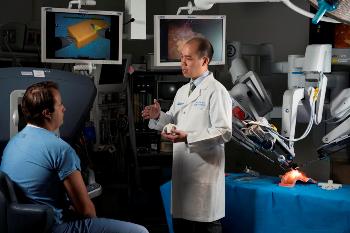May 7 2013
By developing a new way to compare techniques for teaching robotic surgery, doctors at The Methodist Hospital and the University of Southern California report in an upcoming issue of the British Journal of Urology International that surgeons training in robotic surgery learned best when three different teaching methods were used.
 Alvin Goh (right) and a trainee discuss surgical education techniques. Source: MITIE
Alvin Goh (right) and a trainee discuss surgical education techniques. Source: MITIE
Performances in each of three simulation environments – virtual reality, inanimate tasks, and in vivo training -- were compared.
"There is no validated or standardized curriculum in existence for training in basic robotic surgical skills at present," said urological surgeon Alvin C. Goh, M.D., the study's principal investigator and director of robotic urological surgery programs at The Methodist Institute for Innovation, Technology, and Education (MITIE). "To our knowledge, our study is the first in a single setting to simultaneously correlate the performance of expert and novice/trainee surgeons across inanimate, virtual reality and particularly, in vivo platforms."
Goh says that growing interest in minimally invasive, robot-assisted techniques and a general dissatisfaction among urological surgery residents with their robot training has put new pressure on surgery educators to improve robot training. He and his BJUI coauthors examined the usefulness of three robotic training methods, which they developed and independently validated.
Goh's group recruited 38 urological surgery residents and 11 expert surgeons to participate in a hands-on laparoscopic and robotic training course. Course participants were classified as experts or novices based on the number of robotic cases completed as the primary surgeon (30 or more for experts). Participants performed exercises using all three robotic training methods. Virtual reality training used the da Vinci Skills Simulator. A standardized assessment tool, created and tested by Goh and his team, was used to evaluate robotic skills in an in vivo model.
The researchers found certain training methods correlated better with overall performance than others. This unique comparative analysis may help to select better tools for teaching and optimize robotic skills training. Expert surgeons outperformed trainees in all three methods, confirming the validity of these training techniques.
The coauthors suggested that training across a broad range of environments may improve the efficiency of skill acquisition. Further investigation is ongoing to understand how standardized training can improve clinical outcomes.